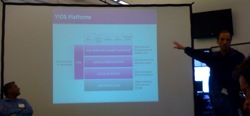 Yahoo plans to release its new application platform next week. The platform is a key part of Yahoo’s “open strategy,” which executives tout as part of their plan to turn around its declining economic fortunes. The idea is to make Yahoo more useful by giving third-party applications a way to plug into and link Yahoo services and user data.
Yahoo plans to release its new application platform next week. The platform is a key part of Yahoo’s “open strategy,” which executives tout as part of their plan to turn around its declining economic fortunes. The idea is to make Yahoo more useful by giving third-party applications a way to plug into and link Yahoo services and user data.
I just left the press briefing for the platform; most of the information was previously available, but this was a chance to get the big picture and find out what’s in next week’s release. The main emphasis so far has been the idea that the unveiling of new user profiles last week was the just the first step in the strategy, which should hopefully turn Yahoo from an old-school web portal into a platform and a hub for your web activity. The new profiles are basically the consumer side, while the application platform will be the developer side.
“Like an iceberg, you’re seeing 1/9th of the tip there,” said Jay Rossiter, the head of Yahoo’s open strategy.
Here’s how Yahoo describes the strategy:
AI Weekly
The must-read newsletter for AI and Big Data industry written by Khari Johnson, Kyle Wiggers, and Seth Colaner.
Included with VentureBeat Insider and VentureBeat VIP memberships.
1. Establish a social dimension.
2. Open to third-parties.
3. Rewire Yahoo from top to bottom.
To make this more concrete, Yahoo offered the application that Xoopit created during a recent “hack day” as an example of what developers might do with the platform. It’s a plugin to Yahoo Mail that aggregates and characterizes media that comes into your account on-the-fly. Later, when you want to build an album of, say, photos of your Aunt Tilly, it has already been gathered for you, and you don’t have to dig through your inbox.
“The point is, we’re not going to build that ourselves, but that data exists,” said Yahoo’s Ash Patel.
One of the platform’s biggest enablers and differentiators is a technology called the “Yahoo Activator.” The activator is how Yahoo turns your contacts in Yahoo Mail, Gmail, Hotmail and elsewhere into connections in Yahoo’s social graph. In the case of Yahoo services, the company will use the activator as a recruiting tool. Yahoo Mail users, for example, can expect to see a message sometime in the next few months asking if they want to add their mail contacts to their Yahoo profiles.
There will be three ways ways for applications to reach new users — through invites sent to friends, a stream of updates/activities and an application gallery. I’m guessing the more social methods (invites and activity streams) will probably be more effective than a standalone gallery, and it sounds like Yahoo agrees.
As for developers, they’ll be able to access data from Yahoo (and through Yahoo from the rest of the web) through a number of methods, including the Open Social platform and Yahoo’s new query language, predictably dubbed the Yahoo Query Language. Yahoo promises the language will be just like SQL, so developers won’t really have to learn a new language.
The platform, including the social application programming interfaces (APIs), goes live next week, although Yahoo isn’t giving a specific date. Initially, developers can only present their applications in a separate, full-page view, rather than integrating more closely as small windows in Yahoo services, but that will change eventually. Yahoo also said that there won’t be an formalized approval process for developers, as long as an app conforms to Yahoo’s security requirements — once your app is live on the web, people can start using it.
So how will this make money for Yahoo? The idea is to create more content and activity on Yahoo properties, which will then lead to greater ad revenue.
And perhaps my favorite moment of the briefing came at the end, when someone asked, “How will we know a year from now if this was successful?” A smartaleck in the audience responded, “If there’s still a Yahoo.”
VentureBeat's mission is to be a digital town square for technical decision-makers to gain knowledge about transformative enterprise technology and transact. Learn More